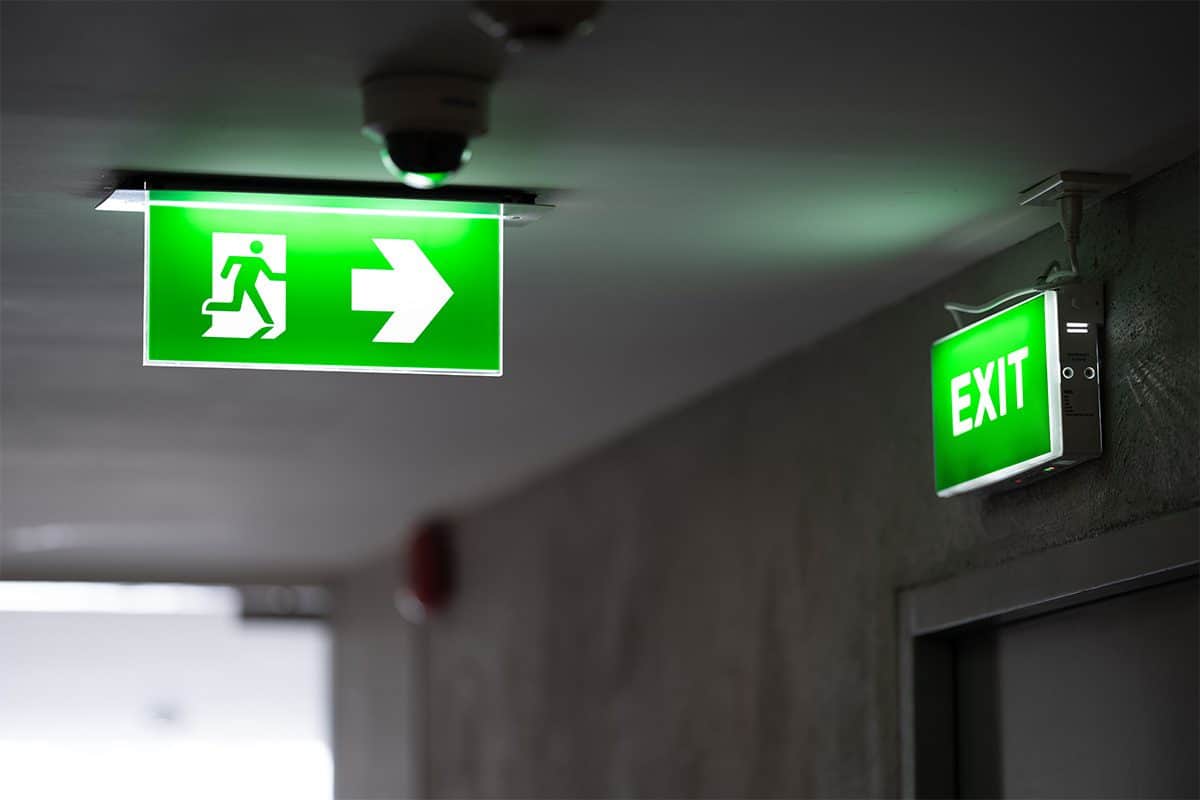Emergency lighting is predominantly found in commercial buildings, and it’s a fundamental safety feature offering illumination when standard lighting fails. It plays a critical role in ensuring the safety and well-being of occupants during emergencies.

Like regular lighting, the systems are typically connected to the building’s main electrical power supply. In the event of a power failure, it relies on backup power sources to continue functioning, and the most common backup power source is rechargeable batteries.
What are the requirements for emergency lighting?
The emergency lighting requirements are based on the building consent when the building was originally built. New building upgrades and consents can trigger the need for an emergency lighting upgrade. The upgrades are required due to regulatory changes to building codes, altered occupancy or significant alterations and renovations, and/or modifications to improve accessibility. Or you may want to upgrade your emergency lighting system voluntarily to take advantage of improved technology.
As an example, a building we upgraded recently had been built in the 1980s. They put in some new doors and upgraded their bathrooms, which triggered a building consent, and from there, the updated emergency lighting was required.
New installations require the exit signs to be on a dedicated circuit. Older factories are possibly on a circuit with lights and other things; it was just the day’s standard.
Emergency lighting batteries are continuously charged when the main power supply is available, ensuring they are ready to operate during an emergency. The duration for which emergency lights remain operational depends on the capacity of the backup batteries, so many modern systems use energy-efficient LED technology, which consumes less power and extends battery life.
Types of emergency lights.
There are two types – exit signs indicating the location of emergency exits and emergency light fixtures that light a pathway in critical areas such as stairwells, hallways and exit routes.
In big premises, when there is a high quantity of fittings, we recommend products that test themselves every six months. This removes the need to manually test fittings and keep paper-based compliance reports, which are time-consuming, inefficient, often inaccurate, and difficult to assess. There is a system with automatic testing, site management and compliance reporting to the mobile world. These systems save you time and money and would pay for themselves over a few years.
Your emergency lighting plan is drawn up by an emergency lighting author who is an expert in the regulations that you need to follow. Once you have consent for your emergency lighting plan, you cannot change it, However, you can add additional lighting.
We recommend putting emergency lighting above your switchboard so you can still have light when you need to check it after a power failure. You might need to flick the switch to reset it, and that’s far easier than finding a torch. When installing without a plan (it might not be needed, but it is wanted), we also recommend outside the front door and the obvious path to exits or the evacuation assembly point – especially if the evacuation is at night.
Maintained vs non-maintained emergency lighting.
Whether you need maintained or non-maintained emergency lighting depends on the building type, its occupants and purpose or usage. It is up to the assessors based on individual circumstances.
Maintained emergency lighting is always on and is mains powered as part of the normal room lighting system. When the power fails, they will stay on for a specific duration, powered by backup batteries. Usually used in non-residential places such as shopping centres, cinemas, bars, swimming pools, etc.
Non-maintained emergency lighting only occurs for a specific duration when the power supply to normal lighting fails. It is usually used in workplaces that are lit when occupied. Non-maintained light fittings are powered by a battery charged from a constant trickle of mains power. If mains power fails, this battery should have enough charge to remain lit for three hours or more.
The process for emergency lighting installation
- The first part of the process is a triggered building consent.
- The architect, designer, builder, or property manager will get a fire report.
- You then provide this fire report to us at French Electrical.
- We will organise the emergency lighting plan and get a PS1*.
- We will provide a quote along with any additional recommendations.
- We will install and test as per the specified design to get a PS3*.
*PS1 is the producer statement design. PS2 is the producer statement design review. PS3 and 4 are then required for the construction stage to ensure the construction complies.
We are an IQP, an Independent Qualified Person – what this means in the electrical industry is we’re better than the average sparky. As PS4 requires, we have the qualifications, experience, understanding and professional memberships to install and test emergency lighting systems.
If you have any questions or a fire report that you want us to plan and quote on, get in touch by phoning us on 0800 945 147 or fill in the form here, and we’ll get back to you.
